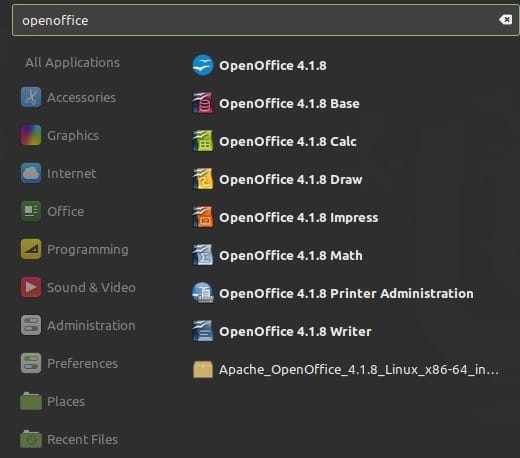How To Install OpenOffice on openSUSE

Apache OpenOffice stands as a powerful, free alternative to commercial office suites, offering a comprehensive set of tools for document creation, spreadsheet analysis, presentations, and more. For openSUSE users seeking a reliable office solution, OpenOffice provides an excellent option that integrates well with this robust Linux distribution. Whether you’re using openSUSE Leap or Tumbleweed, this guide will walk you through multiple methods to successfully install and configure OpenOffice on your system.
Understanding Apache OpenOffice
What is Apache OpenOffice?
Apache OpenOffice is a free, open-source office productivity suite that includes applications for word processing (Writer), spreadsheets (Calc), presentations (Impress), graphics (Draw), database management (Base), and mathematical equations (Math). It originated from the StarOffice software, which was acquired by Sun Microsystems and later became OpenOffice.org. After Oracle acquired Sun, the project was transferred to the Apache Software Foundation, where it continues to be developed and maintained as Apache OpenOffice.
The suite is designed to be compatible with other major office suites, including Microsoft Office, while offering its own unique features and capabilities. It uses the Open Document Format (ODF) as its native file format, which is an ISO-standardized format ensuring document accessibility across platforms and applications.
Why Install OpenOffice on openSUSE?
openSUSE users might choose OpenOffice for several compelling reasons:
- Full compatibility with openSUSE’s system architecture and package management
- Lower resource requirements compared to some alternatives, making it suitable for older hardware
- Strong community support through both OpenOffice and openSUSE forums
- Familiar interface for users transitioning from other office suites
- Complete feature set for professional document creation and management
For home users, students, and professionals alike, OpenOffice offers a stable, feature-rich solution that integrates smoothly with openSUSE’s clean and efficient operating environment.
Prerequisites for Installation
System Requirements
Before proceeding with the installation, ensure your system meets the minimum requirements:
- 256 MB RAM (512 MB recommended)
- 400 MB available disk space for a standard installation
- X Server with 1024 x 768 resolution (higher resolution recommended)
- Linux kernel 2.6 or higher
- glibc2 version 2.5 or higher
For optimal performance on openSUSE, having at least 4 GB of RAM and a modern multi-core processor will ensure smooth operation when working with larger documents.
Preparing Your System
1. Update your openSUSE system to ensure all packages are current:
sudo zypper update2. Install Java JRE, which is required for certain OpenOffice features:
sudo zypper install java-1_8_0-openjdk3. If you have LibreOffice installed, you may need to remove it to avoid conflicts with OpenOffice. Several forum reports indicate compatibility issues between the two office suites:
sudo zypper remove libreoffice-*4. Back up any important documents before proceeding with the installation, especially if you’re removing another office suite.
Installation Methods Overview
Available Installation Options
openSUSE offers multiple approaches to install OpenOffice, each with its own advantages:
- YaST Software Manager: openSUSE’s graphical package management tool provides a user-friendly interface for installation.
- RPM Packages: Downloading and installing the official RPM packages directly from the Apache OpenOffice website.
- Command Line with Zypper: Using openSUSE’s powerful command-line package manager for a more controlled installation process.
- Manual Extraction: For advanced users who prefer to manage the installation manually.
Choosing the Right Method
The best installation method depends on your comfort level with Linux systems and specific requirements:
- YaST is ideal for beginners or those who prefer graphical interfaces
- RPM packages provide the most direct installation from the official source
- Zypper offers more control and is preferred by experienced administrators
- Manual extraction can be useful for testing new versions without affecting system packages
For most openSUSE users, the RPM package method offers the best balance of reliability and simplicity, ensuring you get the official, unmodified version directly from Apache.
Method 1: Installing OpenOffice Using YaST
Adding OpenOffice Repository
Since OpenOffice is not available in the default openSUSE repositories, you’ll need to add a compatible repository:
- Open YaST from the application menu
- Select “Software Repositories”
- Click “Add” to create a new repository
- Select “Community Repositories” and look for “Apache OpenOffice”
- If not available, add a custom repository with the following URL:
http://download.opensuse.org/repositories/office:/openoffice/openSUSE_Leap_15.5/(Adjust the URL based on your openSUSE version)
- Accept the repository key when prompted
Installation Process Through YaST
- Open YaST Software Manager
- Search for “openoffice” in the search field
- Mark all the OpenOffice packages for installation
- Resolve any dependency issues that may appear
- Click “Accept” to begin the installation
- Wait for the installation to complete
If you encounter an error like “Cannot access installation media”, check that the path to your downloaded packages is correct and accessible. Permission issues are a common cause of this error.
Method 2: Installing OpenOffice Using RPM Packages
Downloading Apache OpenOffice
- Visit the official Apache OpenOffice website at openoffice.org
- Choose the Linux version (select RPM packages for openSUSE)
- Select your preferred language
- Click “Download full installation” to start the download
- The download will be approximately 150-170 MB and packaged as a tar.gz file
Extracting the Package
1. Open Terminal and navigate to the download location:
cd ~/Downloads2. Extract the downloaded package:
tar -xvzf Apache_OpenOffice_*_Linux_x86-64_install-rpm_en-US.tar.gzThis will create a directory named after the language code (e.g., “en-US”).
Installing the RPM Packages
1. Navigate to the RPMS directory within the extracted folder:
cd en-US/RPMS2. Install all RPM packages using the following command (you may need root privileges):
sudo rpm -Uvh *.rpm3. Install the desktop integration package:
cd desktop-integration
sudo rpm -Uvh openoffice*-freedesktop-menus-*.rpmIf you encounter an error about conflicts with LibreOffice as shown in the example: “file /usr/bin/soffice from install of openoffice4.1.15-freedesktop-menus-4.1.15-9813.noarch conflicts with file from package libreoffice“, you’ll need to resolve this by completely removing LibreOffice first.
Method 3: Command Line Installation Using Zypper
Finding OpenOffice in Repositories
Before installation, check if OpenOffice is available in any configured repository:
sudo zypper search openofficeIf not found, add a repository that contains OpenOffice:
sudo zypper addrepo https://download.opensuse.org/repositories/home:/some_user:/openoffice/openSUSE_Leap_15.5/ openoffice
sudo zypper refreshInstallation Commands and Options
Install OpenOffice with all components:
sudo zypper install openofficeFor specific components only:
sudo zypper install openoffice-writer openoffice-calcYou can also specify installation options:
sudo zypper install --recommends openofficeThe --recommends flag ensures that recommended packages are also installed, providing a more complete OpenOffice experience.
Post-Installation Setup
Starting OpenOffice for the First Time
After installation, you can launch OpenOffice through:
- The application menu: Look for OpenOffice in the “Office” category
- Command line: Type
openoffice4in a terminal window - File associations: Double-click on a compatible document

When launching for the first time, you’ll see a welcome screen that guides you through initial setup:
- Enter your user information
- Register the software (optional)
- Configure default save locations
- Set up automatic updates
Desktop Integration
Proper desktop integration ensures OpenOffice appears in your application menus and file associations work correctly:
- Verify OpenOffice appears in the application menu
- Right-click on a document and select “Open with” to set OpenOffice as the default application
- Check that file icons show the correct OpenOffice application
- Verify that documents open in the appropriate component
If desktop integration isn’t working correctly, you can reinstall the desktop integration package:
cd ~/Downloads/en-US/RPMS/desktop-integration
sudo rpm -Uvh openoffice*-freedesktop-menus-*.rpmConfiguring OpenOffice
Basic Configuration Options
OpenOffice offers numerous configuration options to customize your experience:
- User Interface: Adjust toolbars, menus, and visual elements
- Navigate to Tools > Options > OpenOffice > View
- Customize icon size, style, and visibility
- Language Settings: Configure spell checking and interface language
- Go to Tools > Options > Language Settings
- Set your preferred language for documents and interface
- Update Preferences: Control how OpenOffice checks for updates
- Access through Tools > Options > OpenOffice > Online Update
- Configure automatic check frequency
- Document Saving: Set default formats and auto-recovery options
- Find under Tools > Options > Load/Save
- Configure auto-save intervals and default file formats
Advanced Configuration
For power users, OpenOffice offers deeper customization:
- Memory Settings: Optimize RAM usage for better performance
- Navigate to Tools > Options > OpenOffice > Memory
- Adjust the amount of memory used by OpenOffice
- Configure graphic cache settings
- Extension Management: Add functionality through extensions
- Access via Tools > Extension Manager
- Browse, install, and manage extensions
- Popular extensions include different dictionaries, templates, and productivity tools
- Customizing Toolbars and Menus: Tailor the interface to your workflow
- Go to Tools > Customize
- Modify toolbars, menus, and keyboard shortcuts
- Create custom toolbars for your most-used functions
- Performance Optimization: Fine-tune for your system
- Disable unused Java features if not needed
- Adjust graphics and visual effects settings
- Configure QuickStarter options
Troubleshooting Common Installation Issues
Dependency Problems
If you encounter dependency errors during installation:
- Check which dependencies are missing:
sudo rpm -Uvh --test openoffice*.rpm - Install missing dependencies using zypper:
sudo zypper install [dependency-name] - Try the installation again after resolving dependencies
Permission Errors
Permission-related installation failures are common:
- Ensure you’re using sudo or have switched to the root user
- Check file permissions of the downloaded packages:
ls -la ~/Downloads/Apache_OpenOffice* - Correct permissions if needed:
chmod 644 ~/Downloads/Apache_OpenOffice*.tar.gz
Launch Failures
If OpenOffice won’t start after installation:
- Launch from terminal to see error messages:
openoffice4 - Check for conflicts with LibreOffice. If you see errors about “/usr/bin/soffice” conflicts, you may need to:
sudo rm /usr/bin/soffice sudo ln -s /opt/openoffice4/program/soffice /usr/bin/soffice - Verify Java is properly installed:
java -version - If necessary, reinstall OpenOffice completely:
sudo rpm -e openoffice*Then follow the installation steps again.
Updating OpenOffice on openSUSE
Keeping OpenOffice updated ensures you have the latest features and security patches. There are two primary methods:
- Using the built-in updater: OpenOffice can check for updates automatically
- Go to Help > Check for Updates
- Follow the prompts to download and install updates
- Manual update: Download the latest version and install over the existing installation
- Download the latest RPM package from the Apache OpenOffice website
- Follow the same installation process outlined in Method 2
- Your settings and customizations should be preserved
For security and stability, regularly check for updates, especially when major new versions are released.
Congratulations! You have successfully installed OpenOffice. Thanks for using this tutorial for installing the Apache OpenOffice on your openSUSE Linux system. For additional help or useful information, we recommend you check the official OpenOffice website.